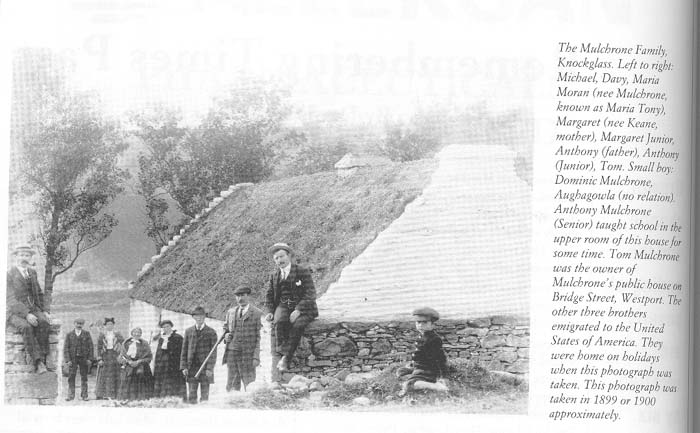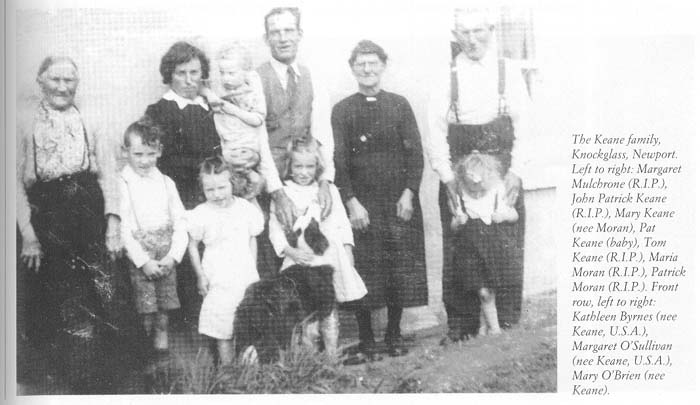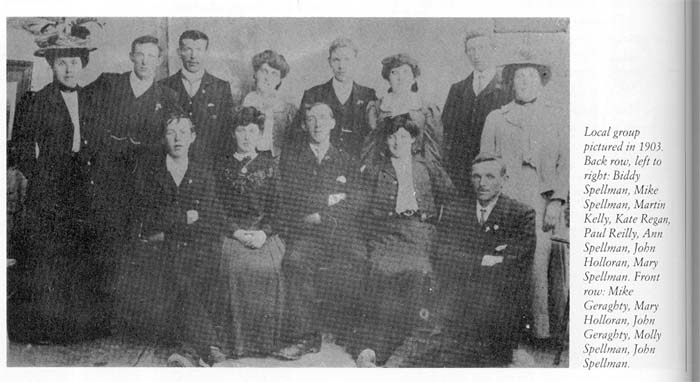
AS a boy, Tom Mulchrone of Derryloughan remembers the tower of Newport Church inching its way above the skyline until it became plainly visible to all the small farms out along the Black Oak river, and from the heights at Cuilmore, Cortoon and Carrickaneady.
It was their church. Their symbol of belonging and achievement, and paid for with the sweat of their voluntary labour.
Newport Catholic Church. Cuilmore National School. Marriages and deaths. Emigration. Growth, change and the ending of stifling poverty are all part of the web of life recalled by six senior citizens: Tom Keane (the Mountain), Tim Mulchrone, Derryloughan; Peter Doherty, Cuilmore; Peter Spellman, Cuilmore, Jim Walshe, Derryloughan and Patrick Geraghty, Cuilmore, called together by Michael Monaghan of Cuilmore to celebrate the past.
Tom Mulchrone, now aged 83 years, remembers them building the Church in Newport. From Derryloughan, as a boy, he could see "the tower rising up over the land and the bell was supposed to waken the people of Shrahmore."
The church was completed in 1918 and Tom Keane (the Mountain) said that he once heard the bell ring out as far away as Derryhummeragh near Islandeady. The bell was donated by a Miss Lavelle of the Quay but it was replaced by automatic chimes in the mid-1970's. The bell was said to weigh a ton and was brought to Newport by train, into the old station at the Oratory.
From the station -behind Kelly's Garage - a team of two horses failed to surmount the steep hill to the church. But the feat was completed by Pat Jennings who used railway sleepers to help stop the wheels of the cart running backwards on the slope.
Voluntary labour was provided by all the houses in the parish in the construction of the new church, which replaced a much smaller building on the site. The old church was later used as a community centre until the Parochial Hall was built in 1940.
Traditional house-dancing, which was a feature of country life in winter time and the cross-roads dancing of summer were, as time went on, gradually diverted into commercial channels and this trend was confirmed with the building of the Parochial Hall.
Peter Spellman remembers that when October came in the house-dancing would start. It would start early and end early, from about 7 to 1030 p.m. "and every house would take a turn." There would also be visiting and card-playing in those days before electricity, when light came from oil lamps and the turf fire. Most young people walked to dances or travelled by bicycle.
In summertime, dancing would take place at McKea's Crossroads in Clooneshil and at the Maypole in Shrahmore. Up to forty young people would gather for these dances in fine weather and they would bring their own music.
That finally ended when the Parochial Hall was built. Mr. Spellman remembers: "He (Fr. Hennelly) would come out to the house if people didn't go to the dances there, or if they went elsewhere."
The other, commercial competition, came from Geraghty's dancehall of Glanisland, Reilly's of Glenhest, the Shamrock in Gortnaclasser, Commons' of Kilmeena and Claggan Hall. Tommy Sweeney played in the Shamrock, the Melody Makers in Kilmeena, the Twilight Serenaders (led by Ger Bracken) in Newport and Moran's Band in Reilly's. Later, Stephen Garvey, Bros Walsh and Tony Chambers came on the scene.
But while pressure was applied to young people to go to Newport, their behaviour there was strictly monitored by Fr. Hennelly, and many a courting couple were warned of the snares of the Devil with the assistance of a stout blackthorn stick.

Change was in the air. And, with the building of the new Church, the practice of burying people directly from their homes declined. Now, t he corpse was taken to over-night in the church. Peter Spellman remembers the last funeral from the area to go directly to Kilbride graveyard. It was that of Ann Rice from Upper Derryloughan and he recalls: "It was in the 1920's. There was a two-night wake and I saw the funeral going back the Lough Road to Kilbride, with the coffin on a sidecar. There were six or seven mourners on saddled horses and a lot of people walking."
The "waking" of the dead, as a tradition involving professional 'caoiners', or cryers, had died out earlier, or perhaps the area was too impoverished to attract them. Certainly, the excesses of drinking which were reported from other parts of the country on such occasions did not seem to occur. Peter Spellman said that people didn't have the money for drink. "T ay and white bread and red jam" was what people usually got, he remembers, and Tom Keane recalls that there were clay pipes, tobacco and snuff for both men and women.
"When they broke up the clay pipes and started to pelt each other with them, there was drink involved," according to Tom. He also remembers the games the young men played on such occasions, to while away the night. There was "thart a bhrog" -around with the shoe - which involved the young men sitting in a circle and passing a shoe under their knees. The objective of the game was to guess which one was left with the shoe and the player who guessed incorrectly was hit with a leather strap.
Even without buying drink for the two-day wake, one man remembered, people would be in debt for years. Times were hard, even if they were getting better.
The first official hearses were drawn by horses and Callaghan's in New Bridge Street (it was known as Tea Pot Lane), in Newport, had one. But many of the poorer people had their coffins brought to the graveyard on a side car, or even on a horse cart.
They were hard times. Tom Keane talks of going to school as a cliild in the 1920's and of getting soaked in the rain. "The clothes were taken off and dried at the fire," he recalls, by the teachers, Mrs. Casey and Mrs. Halloran. "They had changes of clothes at the school. And if your clothes weren't properly dried, you brought them home and returned the school clothes on the following day." There was hardly any "scheming away from school," although some of the older ones did it.
Tom Mulchrone remembers "scheming off" to a ploughing exhibition over at Mairs' farm with Martin McNally. Mr. McFadden (Fadian) the schoolmaster, saw them going over the Lough Road and he sent Jane Callaghan to the house to check on him. The next day, the teacher gave him "slaps, as hard as he could."
Even then, there was a struggle to keep up the 'numbers in the school. Peter Spellman was brought to school in red flannel petticoats - which all young boys wore at that time -at the age of three and was" carried over, roaring and crying from the house" by Maggie McHugh and Tillie Kilroy from Carrickaneady.
"Mrs. Casey would put me in under her desk when I would come and would put a coat over me until I fell asleep. When I awoke later, I would wander around the school. But there were not lessons."
Communion day was a big day and Peter recalls going to Confession, in Newport, with John Joe Joyce. "As we walked in the road, we wondered what we would tell the priest. So we practiced as we went and we disputed if we would tell the bad sins first, or last.
"Cursing was an awful thing and telling lies. But was firing stones any harm, because we were all at that? Or robbing birdeens nests?
"At the end, we had it all planned out. But how many times? That was the hardest part. But we got through that because Mr. Power {the teacher) had prepared us.
"The confession box was strange –looking up for the light -but when the priest pulled the dooreen, you were caught. You had to stick your ground. After the lecture not to do it again, it didn't take long to say the three Our Fathers, Hail Marys and Glory Be's, and we were delighted with ourselves. Did a bit of a skip and a jump on the hill and bought a pennurth of sweets from Mary Davitt's at Cusack's Comer. We didn't get a penny every day, but that day was special," Peter said.
Patrick Geraghty remembers that Confirmation Day was also special. Mr. Power, the headmaster, brought them all to a big meal in his house on the Quay afterwards. Peter Doherty, Peter Moylett, Marty Kelly and Marty Joyce were all in that group and the Archbishop of Tuam, Dr. Joseph Walsh, from Newport, confirmed them.

Doing the Reek pilgrimage was also important. Tom Keane went by special excursion train from Newport to Westport in 1928 and then got a motor car to Murrisk, from where the pilgrimage began. Tom and Jim Mulchrone both remember cycling to Murrisk at night, after the trains stopped running to Achill, to climb the mountain during darkness and to attend 6 a.m. Mass on the summit.
There was no great tradition in the district of going to Scotland for the potato harvest -"tatie hokin" -and emigration tended to be long- term, rather than seasonal.
Farms were small and the land was generally poor, providing a hazardous living. In the 1920's, nearly all of the work on the farms was done by hand. Tillage and turf occupied most of the time and rushes were cut for thatching.
Some extra money could be made in the early 1930's when a programme of bog-road construc- tion was undertaken by the Government. Break- ing stones was one of the jobs available and p~ople were paid two shillings a ton (lOp in today's currency) for such work. The stones had to be small enough to fit through a two-inch ring, or gauge, and it was dull, repetitive work.
The area was so poor that a special subsidy was paid to the Great Southern Railway by the Congested District Board to construct the Achill link, but the hoped for prosperity never came. If anything, the railway destroyed the fragile commercial infrastructure, based on local mills and traffic by sea; The influx of cheaper flour and other provisions and the improvement of the transport system increased commercial competition and made emigration easier.
Before, and for many years after, the coming of the railway, Carey's of Newport was a major commercial enterprise. Not only did the family- later known as Carey-Walsh -own a large establishment on Main Street which included a hardware shop, drapery, grocery and bar. But it also had a flour mill and a timber yard on the Castlebar road and a large grain-drying premises on Georges Street.
Peter Spellman remembers people bringing wheat to be kiln dried on Georges Street. The wheat was weighed on being brought in and it was then spread on a brick floor, which had a large fire burning underneath. The grain was turned from time to time with wooden shovels and John Reagan and Dominick and Michael Geraghty worked there.
A sluice, running from behind the waterfall at the pumping station on the Castlebar Road, brought the water to power the mill which ground the flour. The remains of the mill can still be seen opposite Seamus Kelly's house and houses for the mill workers were built further out the road, at the bridge.

Peter Spellman recalls that the mill was five storeys high and that the kiln-dried wheat was winched up to the top floor and went through a number of processes before it was ground on the second floor and bagged on the ground floor. John Maguire, father of Martin and Sean, was the last miller employed there.
His predecessor, a Mr. King, had been killed at the turn of the century when he was accidentally caught in a huge cog-wheel. The flour was mixed with bran, as needed, in people's homes and they also had their oatmeal processed at the mill. The nature of farming at Carrickaneady, owned by the Mairs family and the Dicks, were at the forefront of modernisation and change. They brought mowing machines to the district and exhibitions were held on their land.
The first horse-drawn plough to come into Cuilmore village went to Doherty's but Tom Mulchrone remembers his uncle Anthony had a light plough made up by a blacksmith, fitted to the handle of a loy (a heavy spade) and drawn by an ass. It was, he says, as good a job as you would get, if you didn't have a horse.
The crops were oats, barley, some wheat, rye for thatching, turnips, mangles, cabbages, potato and carrots. Scythes were used to cut hay and if a man cut half-an-acre in a day it was considered good going. A few outstanding men could clear an acre in a day and Charlie Keane of Cuilmore was one of those.
Young men would hire out for the summer to cut hay, but oats and wheat were cut with a sickle and that was even harder, slower work. Mowing machines had made their breakthrough in the 1950's and the "meitheal" system came into its own, with farmers helping out their neighbours. Seven or eight horse carts would be involved in the final stages of bringing in the hay, with two men forking in the field, two more men forking-up in the haggard and a man tramping and building.
Before the late Dick Mairs travelled the area with the first thrashing machine, wheat was beaten by hand to remove the chaff and secure the grain. On a fine day, the operation was conducted outdoors, where the wind could blow the chaff away, but just as often the job took place inside the house.
Sheets were placed over the dresser to catch the dust and flails -two long sticks hinged in the centre with leatherthonging -were used to beat the ears of wheat.
There was great excitement on the late autumn day that the harvest of oats, or of wheat, were removed from the haggard, where they had been stacked for some time. This was because, invariably, some rats had gathered to the feast and, as each sheaf was removed from the upright pile, their hiding-place grew smaller.
Young boys, old men, terriers and mongrels all gathered for the sport and those who long trousers made sure the ends were tied shut. Finally, the last sheaves were removed and the rats made a run for it, breaking in all directions.
Patrick Geraghty recalls that if the operation was taking place in the haggard of "a contrary man", the helper might let the rat go and hit the ground beside it.
Patrick Geraghty bought the first car in Cuilmore and it was used for everything from christenings to weddings and wakes. It was a Ford V 8 and, ten years old in 1948 it cost the large sum of £260. He had it for three or four years and travelled "all over the countryside. .. wherever I could get a shillin." He went to Knock for the pilgrimages and to Belmullet, when the Blessed Virgin was supposed to have appeared there. There were, he recalls, "thousands of people there praying for the apparition. ..but if I was still there I wouldn't see it." the girl's uncle, he thought, had put her up to it.